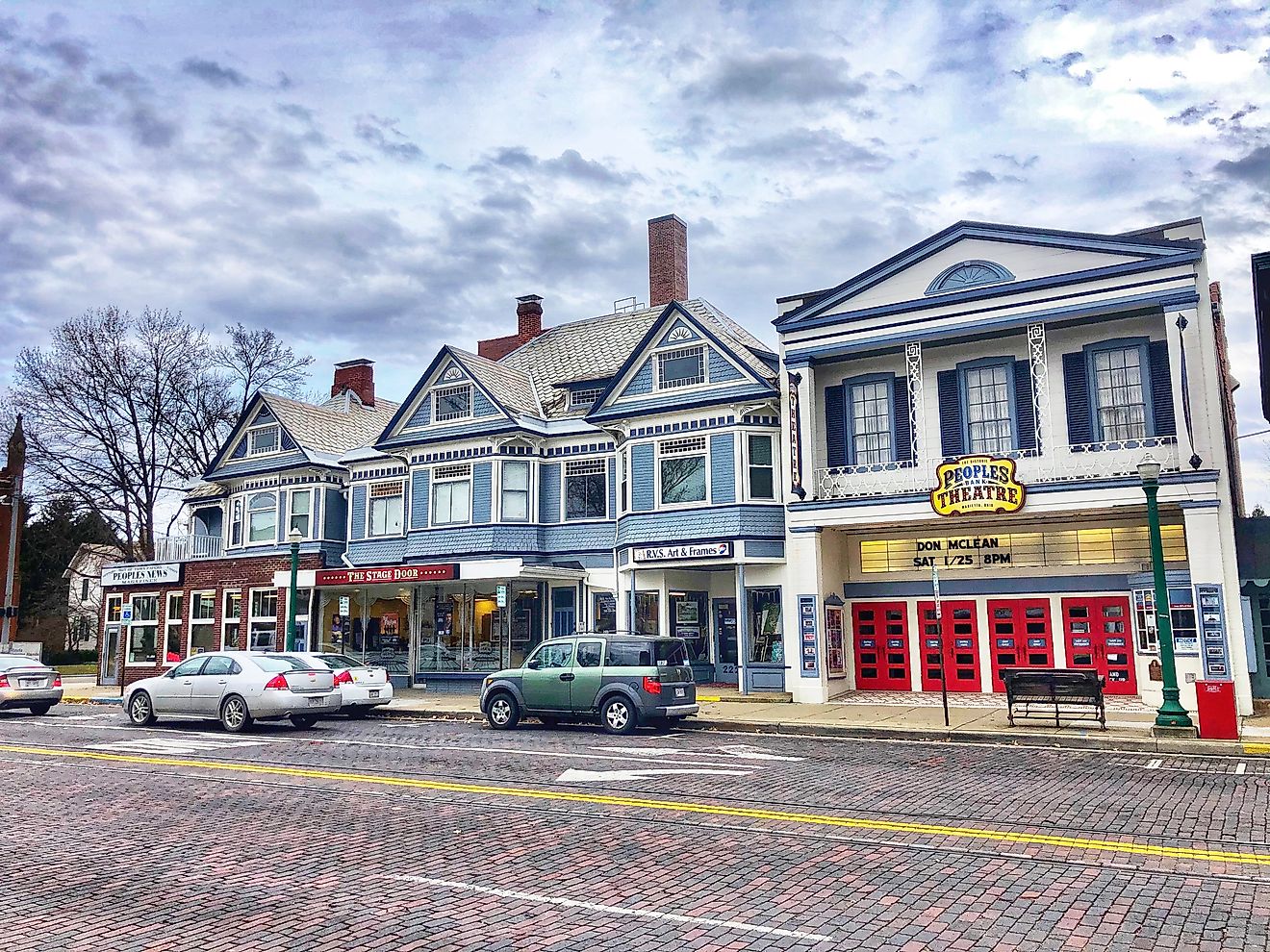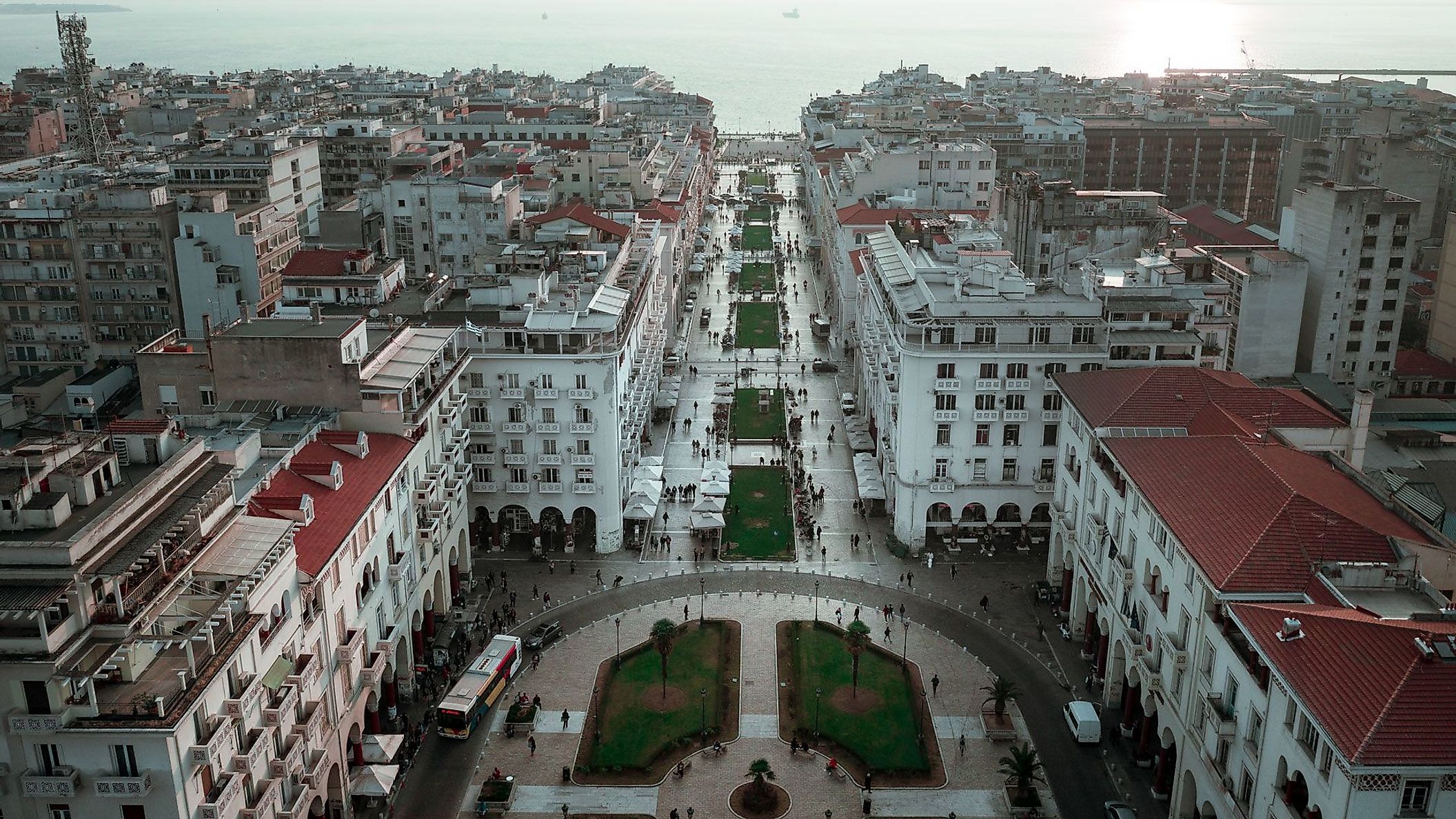
The Best Museums To Visit In Greece
Greece is a unique destination. Too many places to visit, too many things to see, impossible to cover all in a lifetime, even for those of us who live here. Its geography is such that, though comparatively small in land area (131,957 square km/50,949 square miles), it is difficult to even think of visiting all of it. The Greek State includes 6,000 islands and islets scattered in the Aegean and Ionian Seas, of which only 227 islands are inhabited, a unique phenomenon for the European continent and of course an impossible task for any visitor.
Plan wisely, study your trip and be selective. If you cannot see it all, see all that is worth it!
Athens should be your starting point: it is the capital, has many great things to see and it encapsulates the Greek Spirit of both the ancient and the modern urban life of Greece.
The Open Museum Of Urban Street Art
When in Athens, a good starting point for any visitor is to walk the streets around the city centre area, the same streets that for over 3,000 years have guided the steps of humankind through the notions of philosophy, politics, and democracy—all Greek words, by the way.
Feel the urban vibes of modern Athens through the eyes of the many street artists who have created an "open museum" of art. For street art lovers, Athens is the "new Berlin." What is amazing is the abundance of art available to see, because it is everywhere you look. Walking the districts of the most popular areas, Metaxourgeio, Gazi, Exarchia and some streets of Psyrri where you will come across graffiti murals that indeed justify the open museum concept. A short trailer produced by alternativeathens.com will introduce you to the scene.
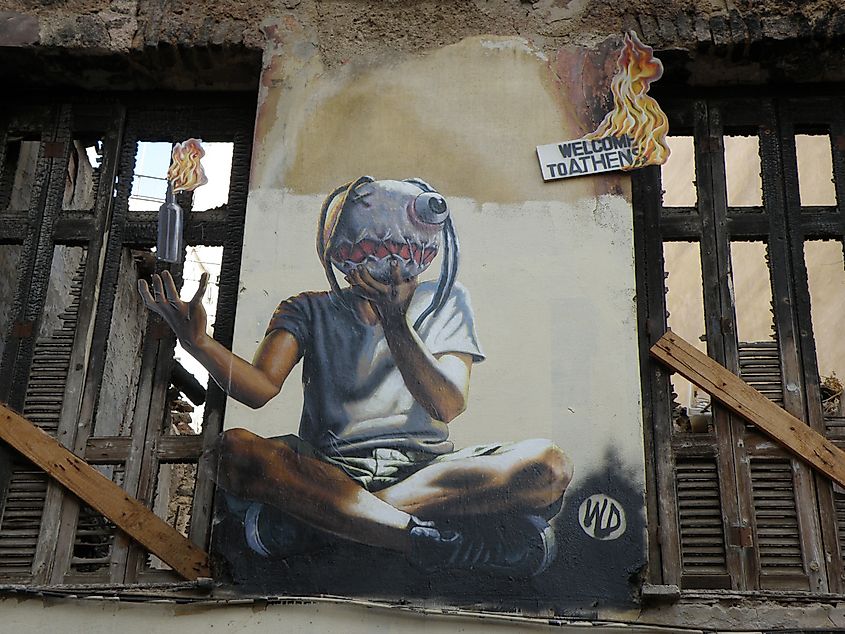
Street Art in Athens, graffiti by WD, in the Exarchia neighbourhood of downtown Athens, via the athensguide.com
|
Fact: The word 'Graffiti' is derived from the Greek word 'Graffein', meaning to write, draw, or sketch, the term was first used in 1851 when inscriptions were found scratched into the walls of the ruins of Pompeii. |
Many renowned Greek and visiting artists are hidden in those Athenian streets and their messages are definitely political and social, expressing modern art in urban architecture.
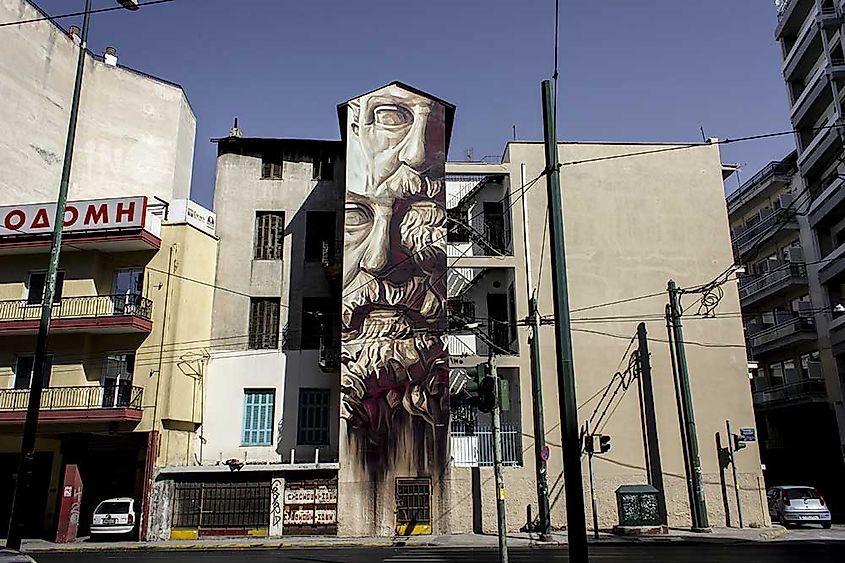
Mural 'System of a Fraud' by renowned street artist INO. It depicts Solon, the father of democracy, on both political sides, left and right, both collapsing, near Omonia Square, Athens.
It is a must when in Athens to schedule the street art tour to view the most important pieces exhibited in the streets. It will save you some time, though it will take out part of the fun of exploring the streets on your own.
The National Archaeological Museum Of Athens
If you chose one museum to visit in Athens, among its multitude of Museums, then make it the National Archaeological Museum. It is the first and oldest museum in the city, founded in 1829. In 1889, it opened its gates to the public.
It is the largest museum in Greece and ranks as one of the most important in the world. It was initially built to display all the 19th-century excavations, mainly from the Attica Region and other parts of the country, but it eventually developed into a national museum with exhibits from all parts of the Greek world. More than 11,000 exhibits present the visitor with a comprehensive view of ancient Greek culture from prehistoric times to late antiquity.
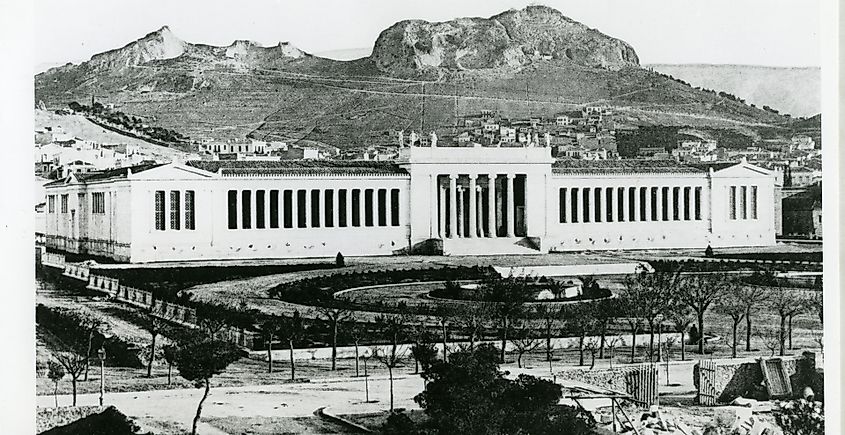
Front view of the building housing the National Archaeological Museum of Athens, via the National Archaeological Museum of Athens.
Within an imposing neoclassical building that covers an area of 8,000 square m., it includes five major permanent collections: 1) Prehistoric Antiquities—displaying works of the great Aegean civilizations from the 6th millennium to 1050 BCE (Neolithic, Cycladic, and Mycenaean periods) and finds from the prehistoric settlement of Thira; 2) Sculpture works, presenting the evolution of ancient Greek sculpture from the 7th century BCE until the 5th century CE through unique works of art; 3) The Vase and Miniature Collection, which includes representative works of ancient Greek ceramics from the 11th century BCE up to the Roman era; 4) Metalworking with many unique original works, statues, figurines and miniature crafts; and 5) Egyptian and Eastern Antiquities with works of art dating from the pre-emptive period (5000 BCE) to the times of the Roman conquest.
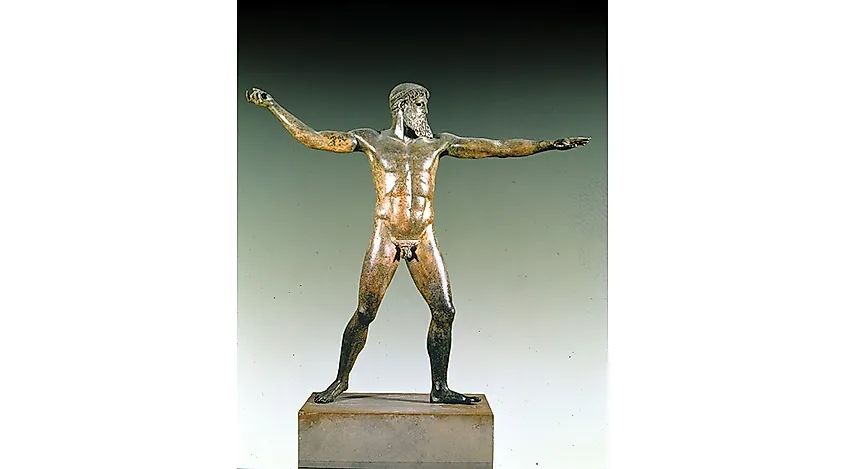
Bronze statue of Poseidon or Zeus. From the sea area near Cape Artemision, Northern Euboea. About 460 BC, via National Archaeological Museum of Athens.
You will need to spend at least 2 hours to briefly take in the displays, and if you have the luxury, spend more time to really ponder over the evolution of art, the spirit of the artists and the beauty that is abundantly diffused within the halls of this great museum.
The National Museum Of Contemporary Art, Athens
If contemporary art is included in your interests, then plan to visit the "youngest" museum in Athens that opened fully operational to the public this year, in February 2020.
The National Museum of Contemporary Art Athens (EMST) is housed in a renovated old brewery building, the old FIX brewery, an Athens landmark on its own merit near the centre of Athens and is spread over 18.142 square m.
The Museum’s constantly growing collection is formed around a particularly important nucleus of works by Greek and international artists, and in its permanent exhibition, many art forms are exhibited.
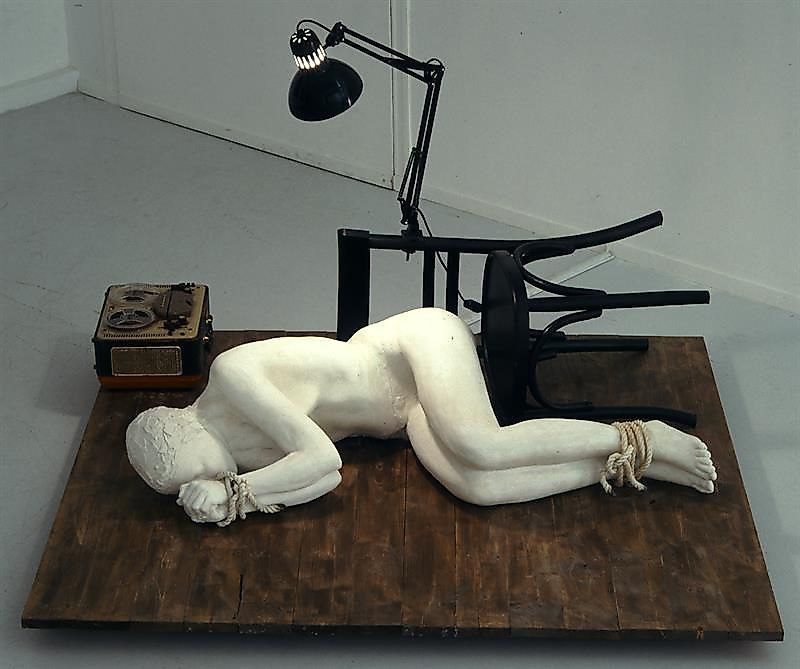
Sculptural Installation, by Dimitris Alithinos, 1973, via the National Museum of Contemporary Art, Athens.
The exhibition of the permanent collection includes 172 artworks created by 78 Greek and international artists and they are displayed in thematic halls that express the artists’ intentions such as: Memories, Claims and Political narratives; Limits and Passages; and Heterotopias, the Mythology of the familiar, and a separate hall for new and innovative perspectives.
Museum spaces include the Media Lounge, the Conservation Laboratory, the Library and Artistic Archive, and the Screening Room.
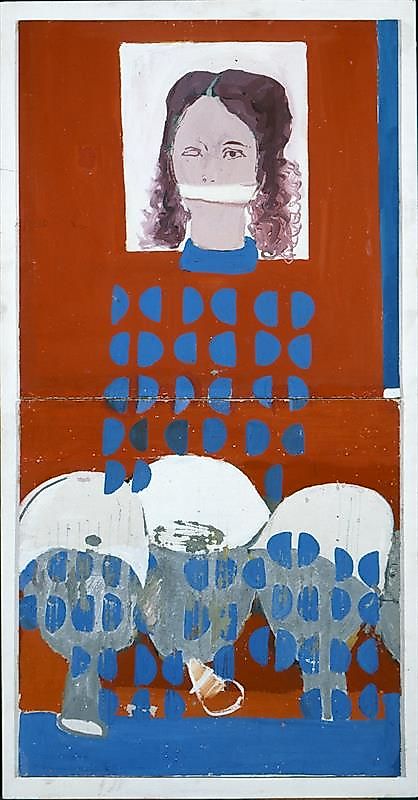
Painting, by Dimosthenis Kokkinidis 1968, via the National Museum of Contemporary Art, Athens.
The National Museum of Contemporary Art Athens (EMST) is a short visit, with less than an hour needed to glimpse into the "new scene" of art expression from Greek artists and their influences. The old brewery building is quite impressive and pleasant to walk through and as it is centrally located it can be part of a pleasant stroll from Constitution Square, past the Hadrian Gates and onto the ancient thoroughfare that connected Athens to the seafront, today known as Syngrou Avenue.
The Museum Of Cycladic Art, Athens
Now, this is a museum close to the heart! It takes us back to the dawn of human presence, the first culture that emerged and claimed notoriety as an "art-producing" society in Greek history, and depicts a universal concept of humanity.
The Museum of Cycladic Art is known worldwide for the displays of one of the most comprehensive collections of Cycladic art, with characteristic examples of statuettes and figurines, vases, tools, weapons, and pottery from all phases of the unique Cycladic island culture that flourished in the central Aegean during the third millennium BCE, referred to as the Early Bronze Age.
Carved statuettes in marble depicting the human form are the most typical product of Cycladic culture, and their abstract forms have influenced several 20th- and 21st-century artists in their contemporary creations.
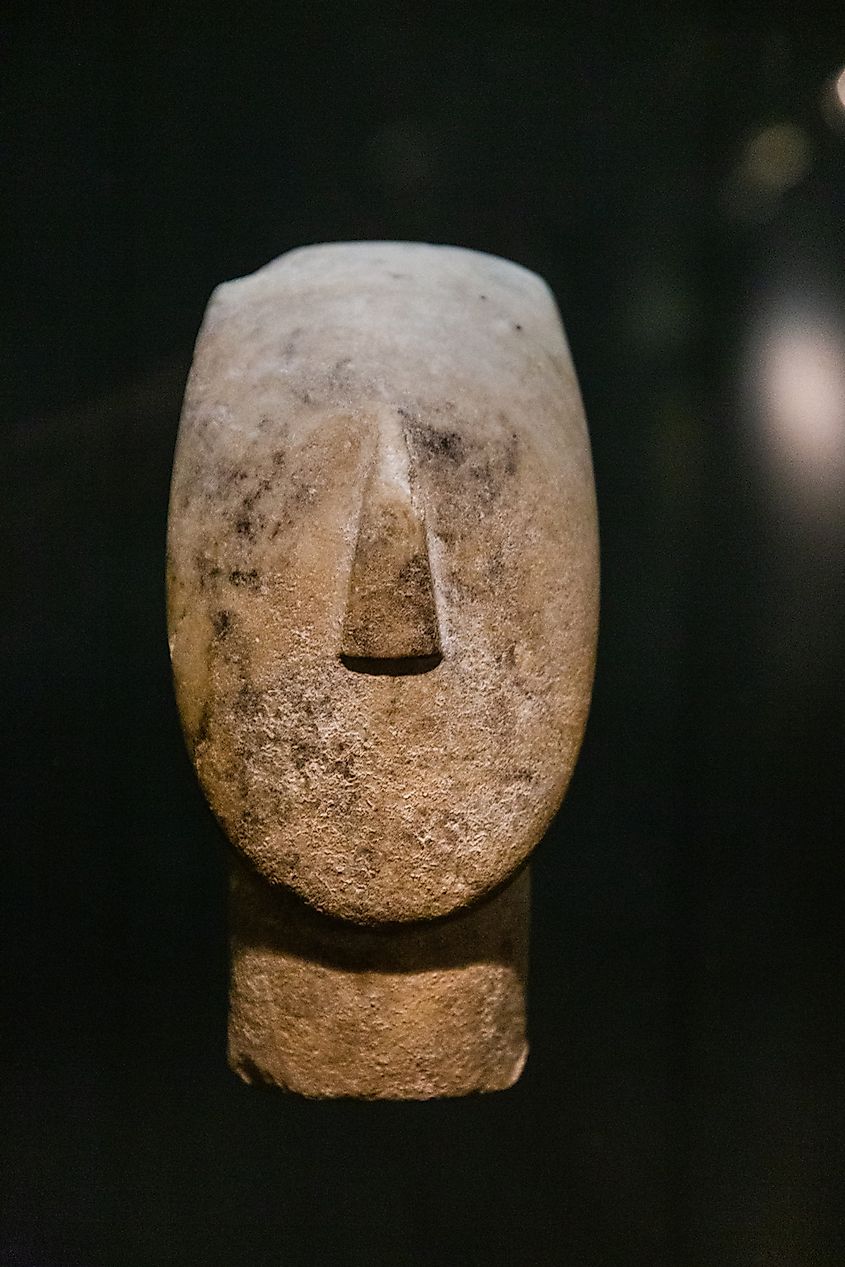
Face of Cycladic statue, via the Museum of Cycladic Art, Athens.
The island of Melos, one of the 220 islands forming a circle around the Sacred island of Delos, thus called the Cyclades (from the root of the Greek word Cycle) was apparently the first where traces of human activity was present. The prevailing theory is that people from mainland Greece travelled to the island in search of high-quality obsidian. This hard-volcanic rock was extensively used throughout the Aegean in the Neolithic period and later in the Bronze Age for the manufacture of cutting tools and weapons.
The Cycladic Civilization, video produced by the Cycladic Museum of Athens
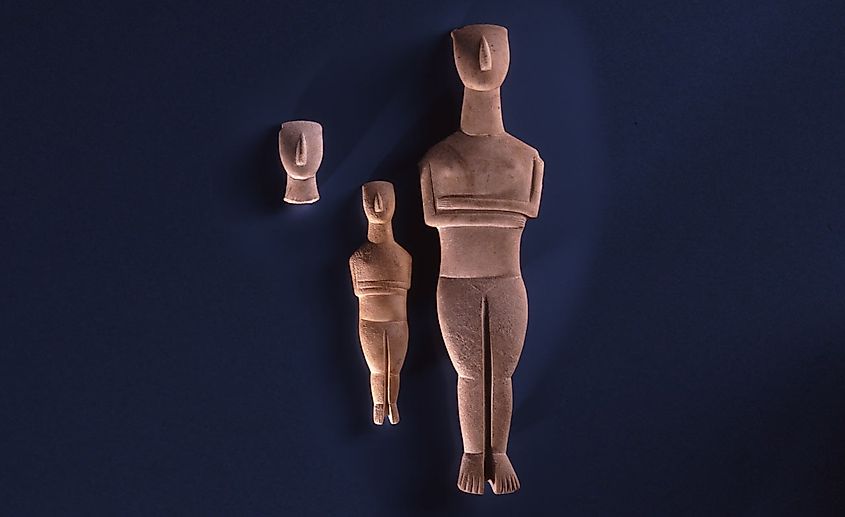
Marble figurines are the most impressive creations of Cycladic art, via the Museum of Cycladic Art, Athens.
The statuettes usually depict nude female figures with arms folded above the abdomen, slightly flexed knees and a barely uplifted backward-slanting head. This is the typical sample, referred to as “canonical” by scholars, and it accounts for the overwhelming majority of figurines sculpted at the zenith of this culture, known as the Early Cycladic II period (2800-2300 BCE). They vary in size from miniature examples to almost life-size sculptures, but most of them are about 40 cm high.
Also displayed in various halls of the museum are marble sculpted everyday objects, such as bottles, plates, cups and vessels with animal shapes, also metal objects, such as bronze tools and weapons, heavy figurines made from lead, and silver vessels.
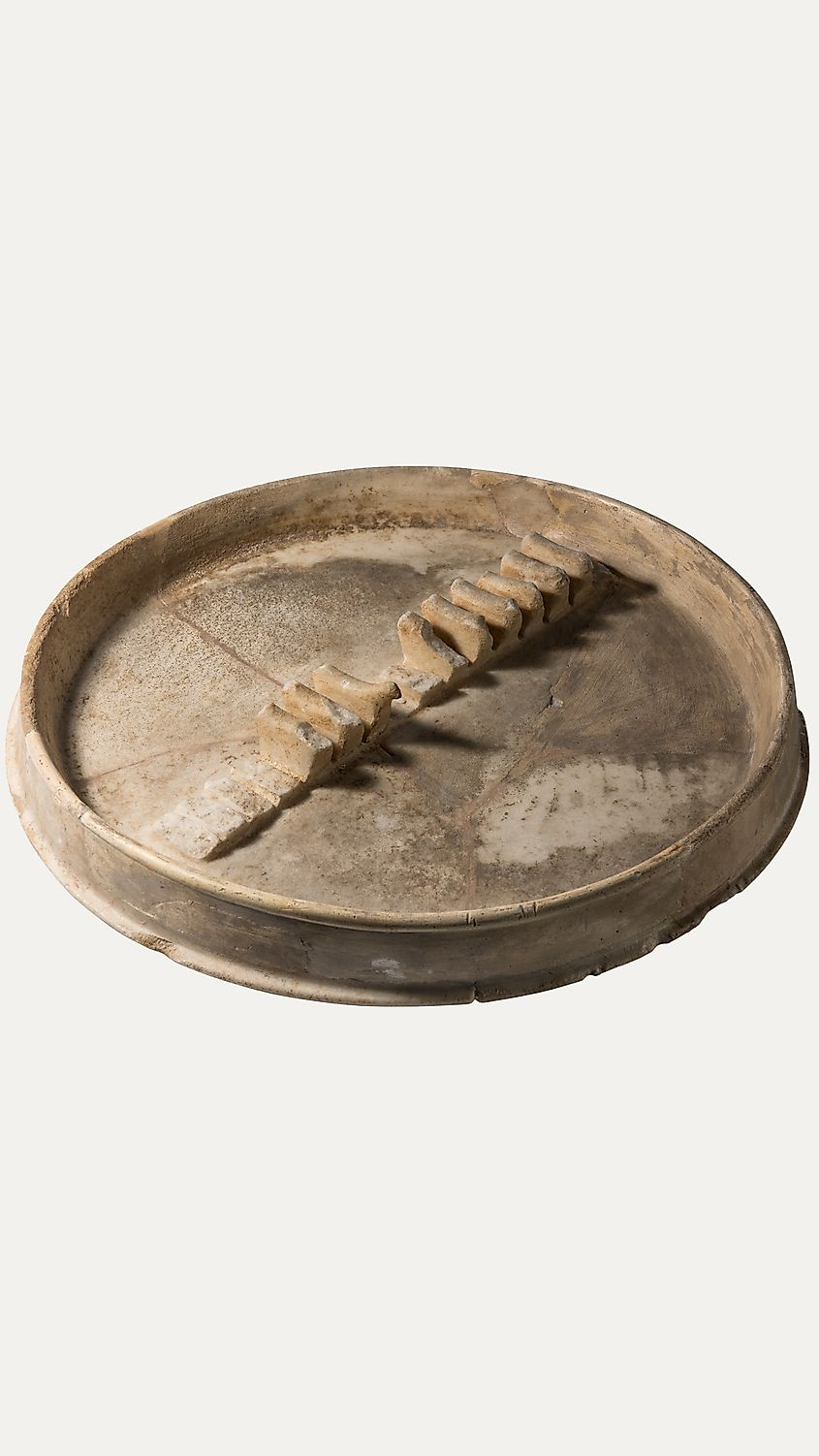
The Dove Vase or Vase Pigeon, circa 2800-2300 BC via the Museum of Cycladic Art, Athens.
The star display of the museum is this beautiful, almost life-size statue of a woman, from the Early Cycladic II period, standing at a height of 1.40 meters, a typical but impressive work of art.
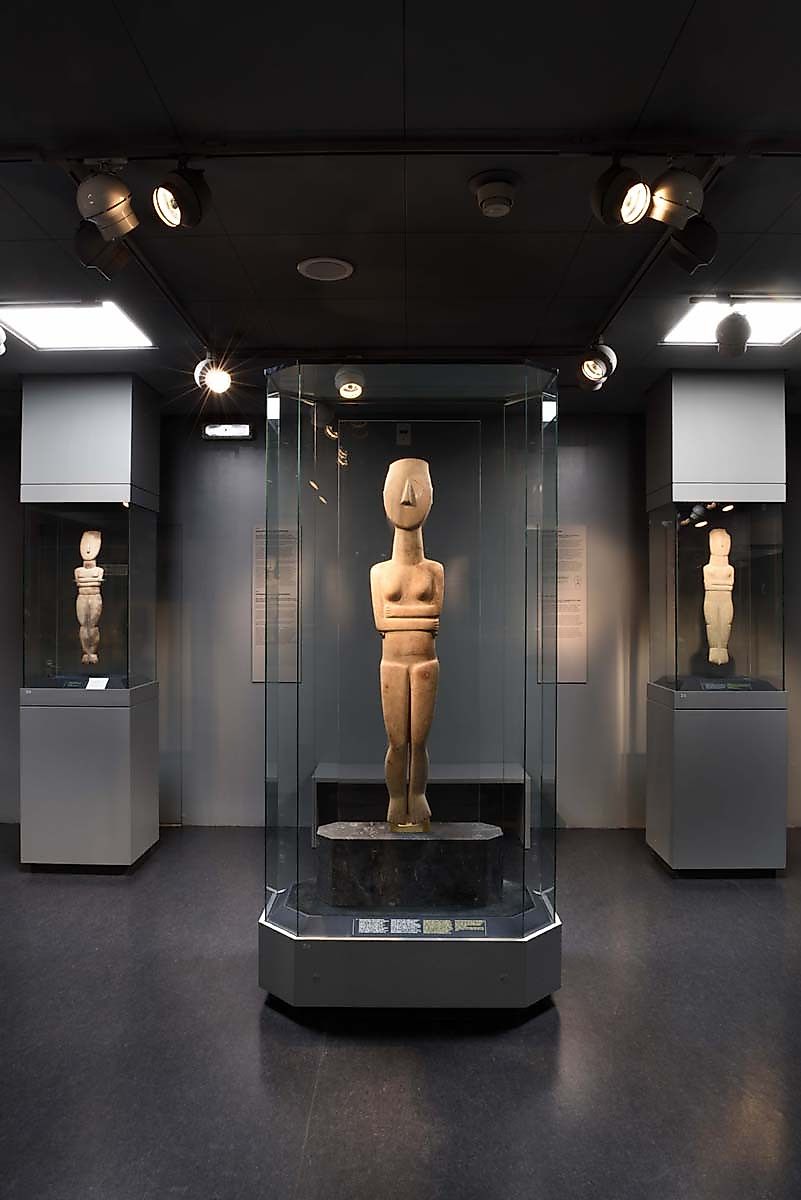
Female statue of the Spedos variety, early Cycladic, via the Museum of Cycladic Art.
The charm of this museum, besides the splendour in the simplicity of its artifacts, lies in the power of the human spirit expressed through perfection and proportion, the anthropocentric character so early depicted in art and in forms and shapes that have endured till today and have inspired many great contemporary artists, including Pablo Picasso, Constantin Brancusi, and Amedeo Modigliani.
The Archaeological Museum Of Delphi, Delphi
Travelling north of Athens, at about 120 km (75 miles), lies the ancient sanctuary of Delphi, dedicated to god Apollo, a place of reverence for all ancient Greeks set in an awe-inspiring landscape. It is situated on the base of the gigantic rocks of Parnassus, the Phaedriades (the shining rocks). The rocks are split, forming an awesome chasm. Its clefts emitted the vapours in which the ancients saw the spirit of Apollo and gave way to the flow of purifying water from the sacred spring of Castalia; all visitors had to wash and purify themselves at the spring before entering the sacred grounds.
The place is indeed magical, carrying the aura of collective human energy and the power of the surrounding nature that can be felt by the visitor. The ancients called it the "navel" of the earth, the centre of all primeval powers, a venerated place of worship and oracle-seeking wisdom.
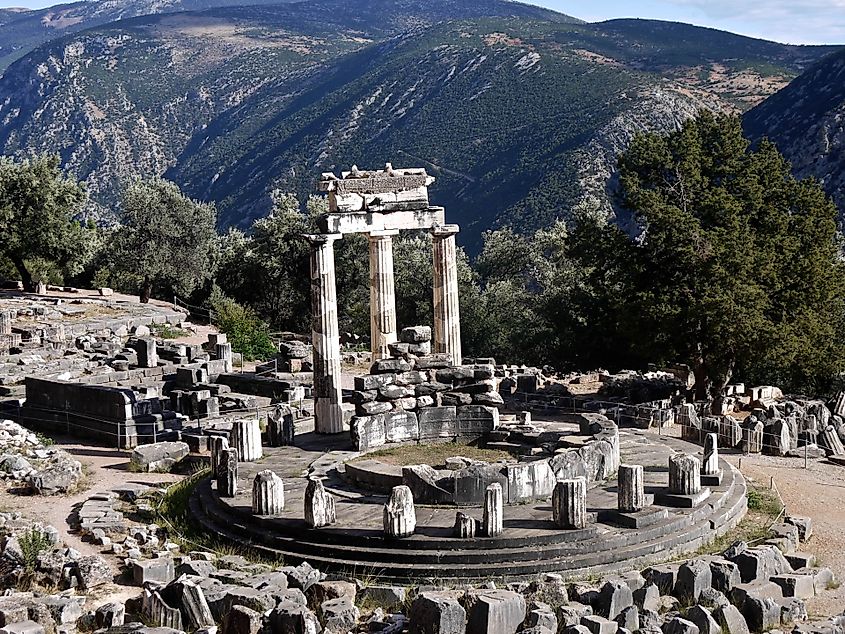
It will take you a few hours to wander around the ruins of the sanctuary, starting at the temple of Athena and ascending to the sanctuary of Apollo. A winding path, the Sacred Way led to the imposing temple of Apollo, which overlooks the shrine from its centrally located, amphitheatrical and elevated position. In the Adyton (Ancient Greek: ἄδῠτον [ádyton], "innermost sanctuary, shrine," literally meaning "not to be entered" or Adytum, Latin, was a restricted area of a Greek or Roman temple) of this temple, a separate closed room at the rear, Pythia, the oracle, seated on the tripod, uttered the prophetic—and by all accounts unintelligible—words of the god. The Doric temple we see today was completed in 330 BCE, commissioned for restoration by Alexander the Great, and it was the last in a succession of six temples built on the site in honour of Apollo.
The grounds where the Archaeological Museum of Delphi is situated houses the treasure of artifacts brought to light by the excavations since it was built in 1903. Successive expansions of the exhibition areas from the 1950s onwards led to the contemporary museum, which was last refurbished in 2000.
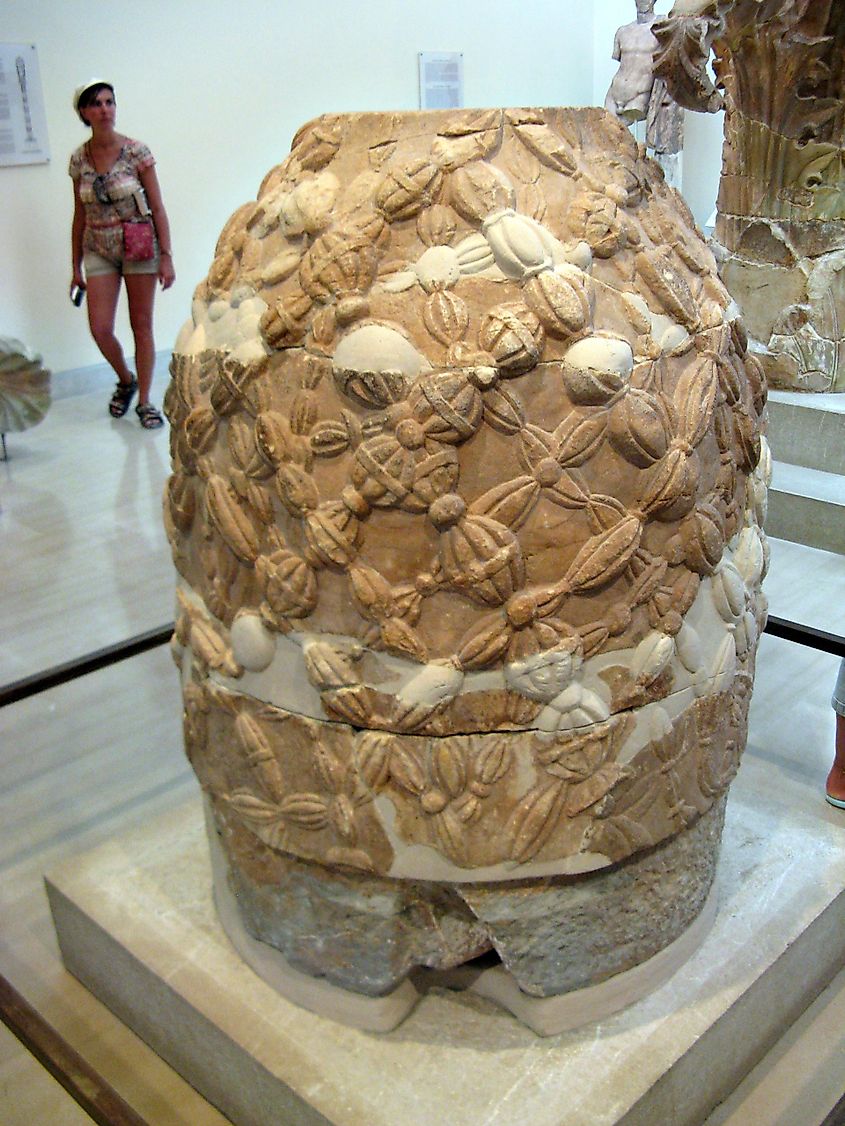
The sacred symbol of Delphi, the omphalos (navel) marble copy of the Hellenistic times has been found and is on display in the museum today, via the Archaeological Museum of Delphi.
The navel symbol signified that Delphi was the centre of the earth, spiritually and geographically. It was kept in Apollo's temple, while effigies of the sacred omphalos were positioned in several spots of the sanctuary.
The museum accommodates one of the most valuable collections of ancient Greek art. These works, along with the architectural monuments that once adorned Apollo's sanctuary and the surrounding grounds set in human and nature’s splendour account for a vast open-air museum of great significance.
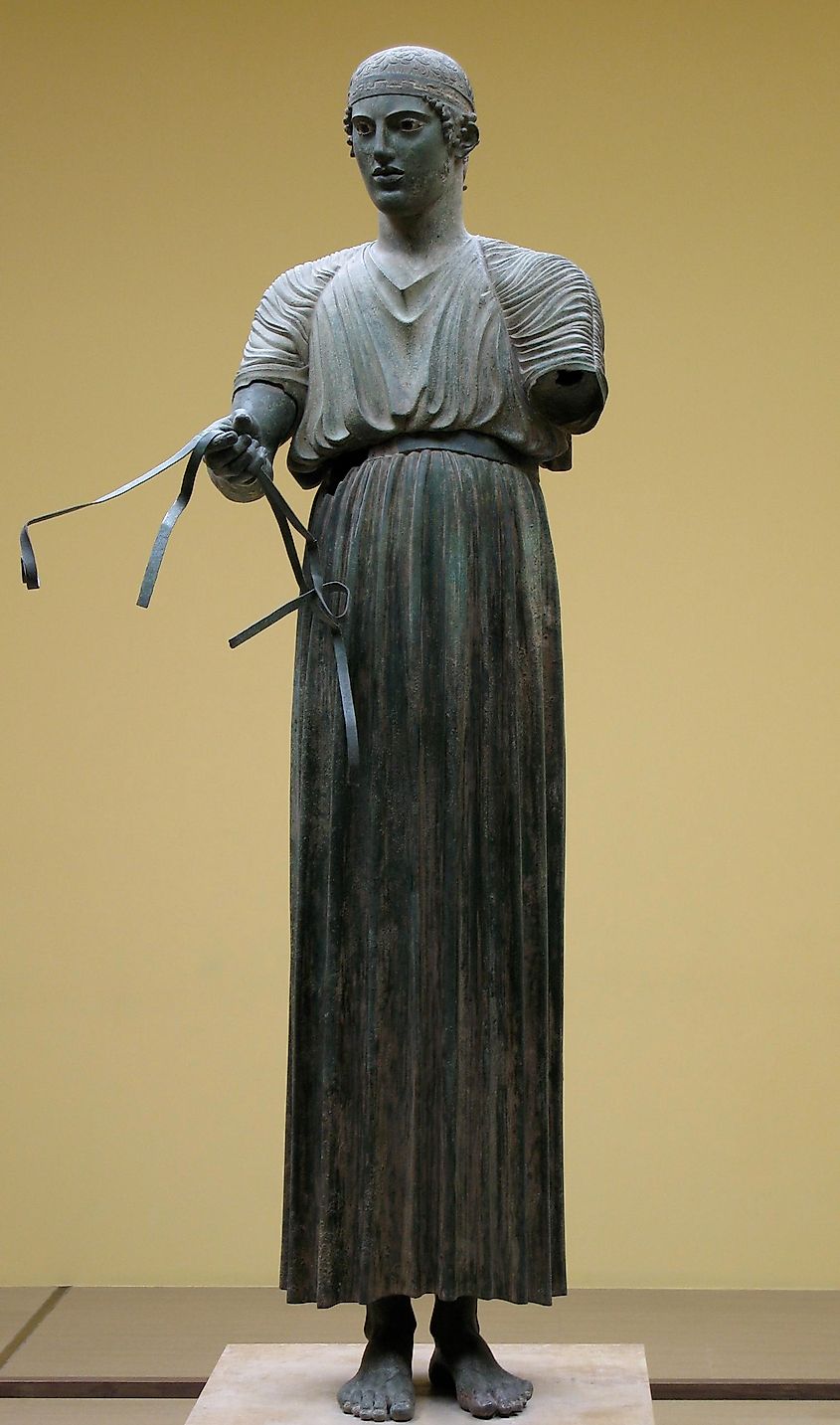
The famous Charioteer belonged to a bronze statuary complex of a chariot run by four horses and included a second male figure, via the Archaeological Museum of Delphi.
The statue was an offering by the tyrant of the powerful city-state of Gela in Sicily, Polyzalos, in 475 BCE after his victory in the Pythian Games around 475 BCE. It is considered a finely preserved masterpiece of classical art sculpted in bronze, a rarely preserved material in the archaeological record, as it was often plundered in later years for the value of bronze as a raw material.
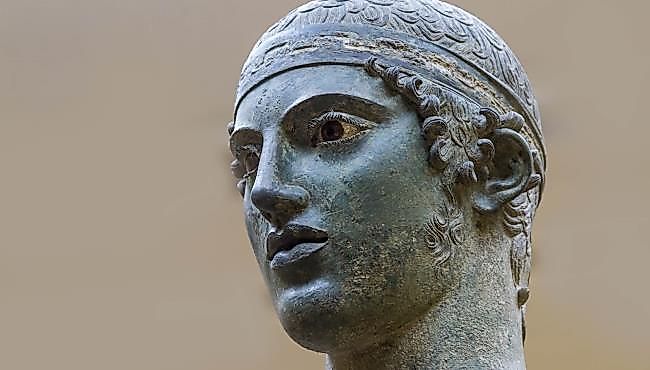
Close view of the head and face of the Charioteer, via the Archaeological Museum of Delphi.
So when in Athens, plan to take the one-day trip to Delphi. It is a beautiful journey through the mountains and the visit is rewarding. After all how many times in a lifetime one can visit the navel of the earth! There are many daily tours operating to Delphi and you can find the one that best suits your needs.
The Museum Of Byzantine Culture, Thessaloniki
The northern city of Thessaloniki is the second-largest city in Greece, the capital of the north as it is often referred to. It is a vibrant city with a long and rich history through the Roman and Byzantine era with a large seafront promenade that adds to its architectural beauty.
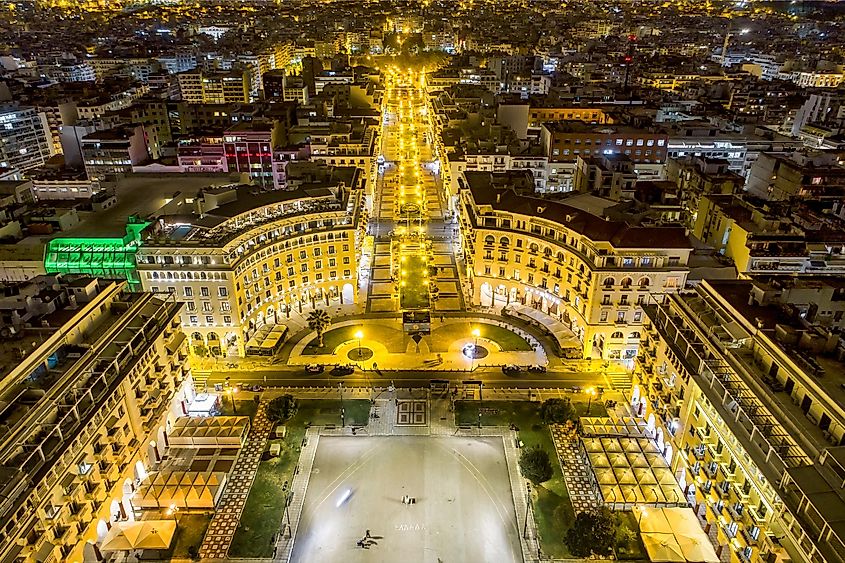
Aerial view of famous Aristotelous Square the night in Thessaloniki city. Thessaloniki, main square, view from above, via discovergreece.com
The city is an open Byzantine era museum, and 15 of its early Christian churches have been declared UNESCO World Heritage Sites and it can take a visitor hours and even days to wander through all those landmarks.
Once in the city, a must-visit to the Museum of Byzantine Culture will take you through centuries of Christian art and tradition.
The building of the museum is listed by the Greek Ministry of Culture as a historical monument and a fine example of architectural art for modern Greece.
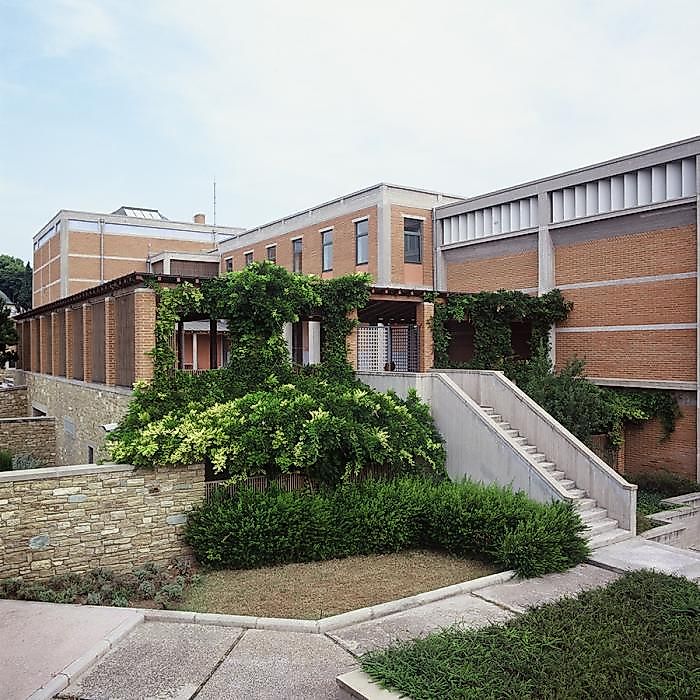
General view of the building, via the Museum of Byzantine Culture, Thessaloniki.
The main characteristics of the Museum are the spacious atrium with the surrounding gallery at its entrance. It is built on 15.439 square meters of land and the building itself covers a surface of 5.371,27 square meters. In the 11 large halls, all aspects of the Byzantine and post-Byzantine culture are presented through the display of original artifacts, mainly from Thessaloniki, the most important city of the Empire after Constantinople, but also from the wider area of Macedonia.
The collection numbers more than 46,000 artifacts, but space allows only 3,190 on display, which includes heirlooms and artworks dated between the 2nd and the 20th centuries. Icons, murals, mosaics, marble architectural elements, early Christian tombs, liturgical church vessels, implements for personal adornment, humble everyday artifacts, and tools for professionals are on display as artworks and as a legacy of the culture and the society of the great Byzantium.
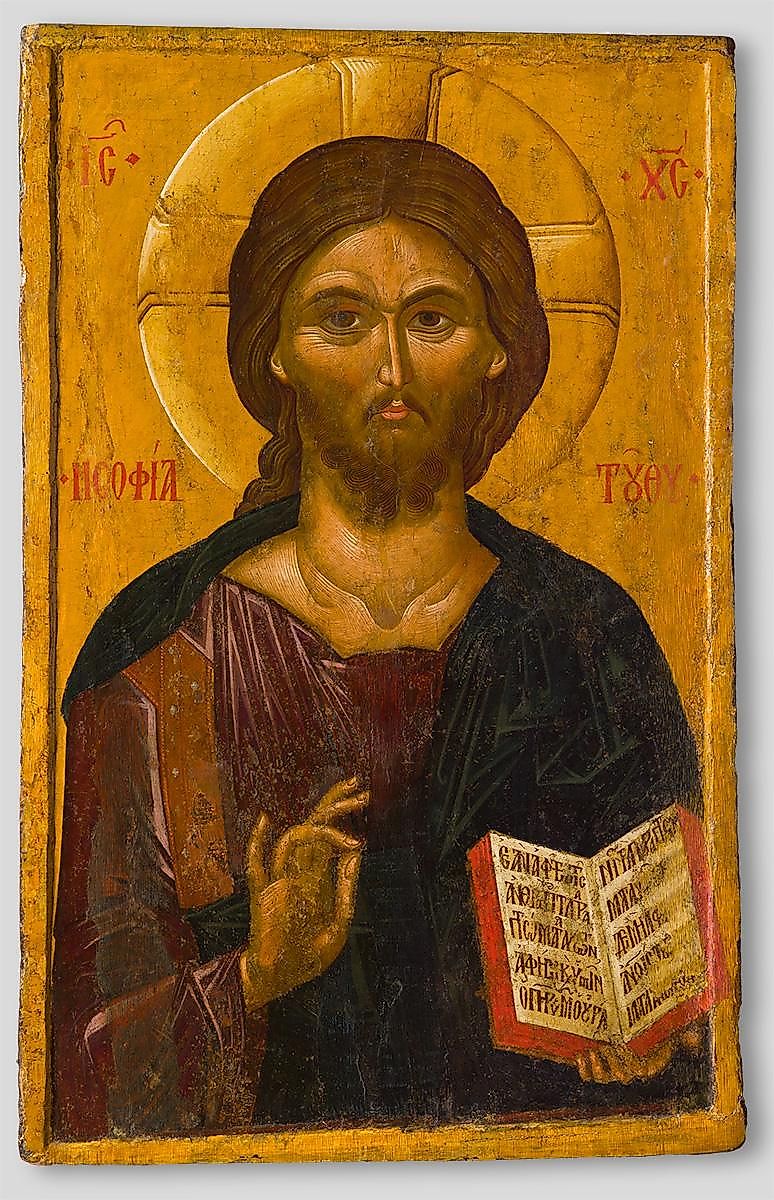
Icon of Christ Pantokrator – Omnipotent, late 14th century, Dimensions: Height 157 cm; length 105 cm; width 5 cm, wood, egg tempera, via the Museum of Byzantine Culture, Thessaloniki.
From the collection of the permanent exhibits the icon of Christ the Pantokrator, Omnipotent, is a masterpiece of Byzantine Art and a prototype for icons. Christ is depicted offering the typical blessing with his right hand while holding in his left hand an open book with an excerpt from the Gospel of Matthew, stating his attributes of mercy and omnipotence.
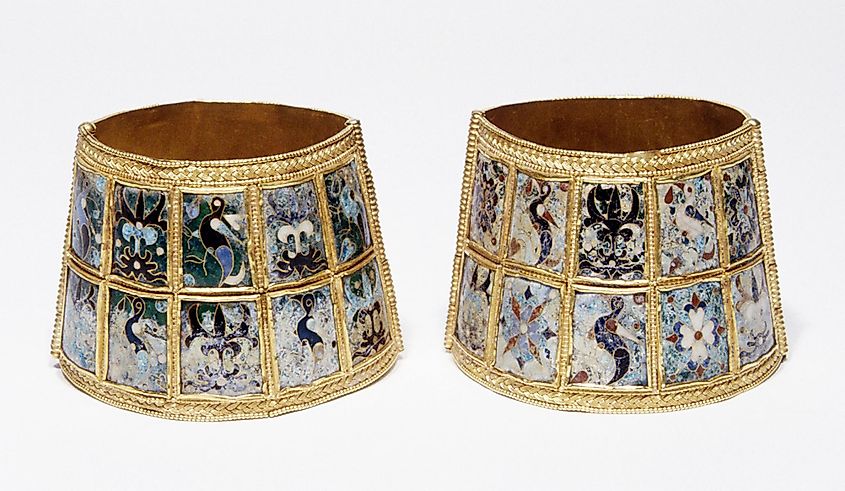
Pair of gold bracelets, gold and glass, 10th c., origin Thessaloniki, via the Museum of Byzantine Civilization.
A fine example of Byzantine jewellery is this pair of gold bracelets, crafted in gold and glass. Each bracelet is covered by 20 tiles that are defined by granular strips and are decorated with cloisonné enamel, depicting birds pecking at leaves, palms and rosettes, and rendered in different color variations.
The entire museum offers the visitor a sense of spiritual elevation and it is a profound religious experience regardless of creed and strength of faith. That early period when the Christian faith avenged for its earlier prosecution by aspiring to reach unprecedented levels of splendour and grandeur.
Thessaloniki, the Bride of the North as we Greeks refer to the city, is worth a visit for its Byzantine past and its exquisite cuisine. The food and the city come straight from heaven!
The Silversmithing Museum Of Ioannina
In the northwest part of Greece lies the city of Ioannina, capital of the Region of Epirus. This picturesque city built on a lake surrounded by impressive mountains used to be a centre for the region through Byzantine and Ottoman times. Ioannina is one of the most enchanting cities in Greece, beautiful and brimming with history, built on the shores of Pamvotida Lake which features a gorgeous promenade running by the water’s edge and an island at its center, complete with historic monasteries.
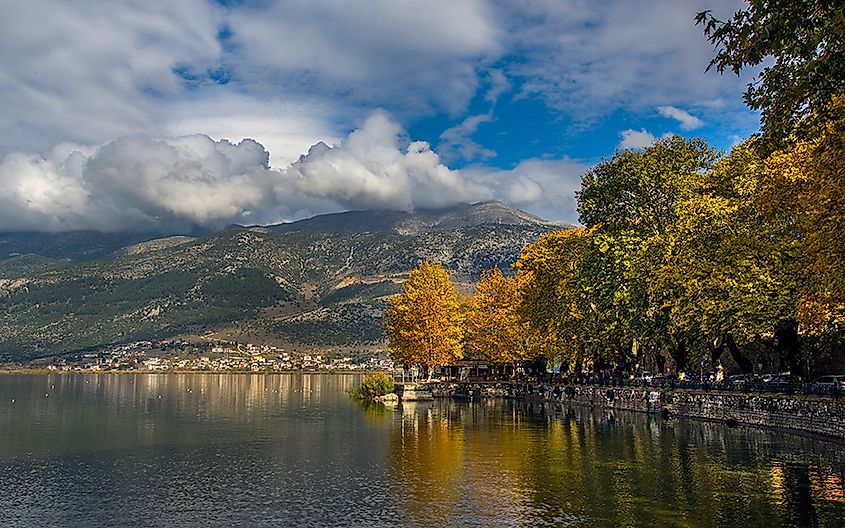
Ioannina City, view from the lake, via Greece-is.com
Ioannina’s castle, with the famous southeastern citadel of Its-Kale, and the stories of the colorful Ottoman ruler Ali Pasha (1740-1822) who ruled the city for 34 years before being executed by the Ottoman central government, help define the city’s unique atmosphere. It is a medieval city that has evolved to accommodate its busting modern life but has rigidly preserved its architectural tradition that goes back through the centuries.
It was always a multicultural city, with strong Jewish and Turkish communities, and this mix has enhanced its social and architectural character.
There are many things to see and enjoy in Ioannina, like visiting the city’s nine museums: the Archaeological Museum, the Byzantine Museum, the Treasure Chest of Ioannina, the Folklore Museum, “Kostas Frontzos” Museum, the Municipal Museum, the Silversmithing Museum, the Museum of Ali Pasha and Revolutionary Period, and the Historical Museum of Ioannina Ch. Nikolaou. Of those, my personal favorite is the Silversmithing Museum located in the city’s medieval castle, which commemorates the city’s long tradition as the centre of silversmithing and the exquisite art objects it produced and still produces, as the city is still actively producing silver jewellery and decorative pieces of silver.
The Silversmithing Museum of Ioannina is located in the castle of Ioannina, and more specifically in the western bastion of the north-eastern acropolis (Its-Kale). It occupies the bastion’s two levels, as well as the adjacent building of the old cookhouses.
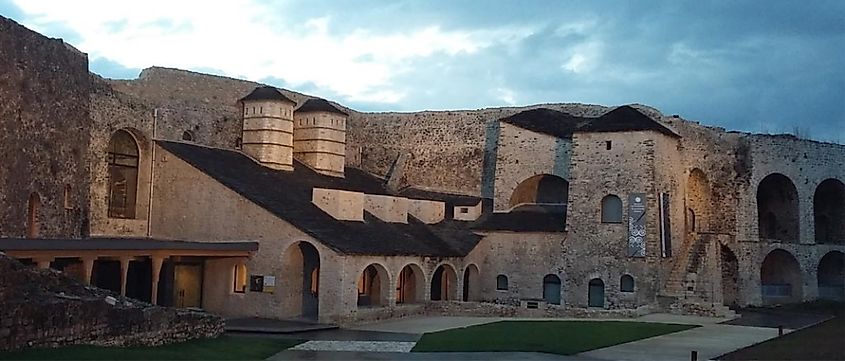
General view of the Silversmithing Museum of Ioannina, via The Piraeus Bank Group Cultural Foundation.
The objective of the museum is to conserve the knowledge and craft of silversmithing inherent to the region and to disseminate information about its technology to the wider public. Also, to tie this technology into the social context of the period during which it was developed and flourished.
The museum presents the history and techniques of the craft that brought wealth to Ioannina from the late Byzantine period onwards. The tour over the two floors of the museum is set to the sounds of working metal. Possibly the most impressive room is the one displaying works from the 18th to the 20th century: incredibly artful pieces of weaponry, jewelry, as well as, everyday items.
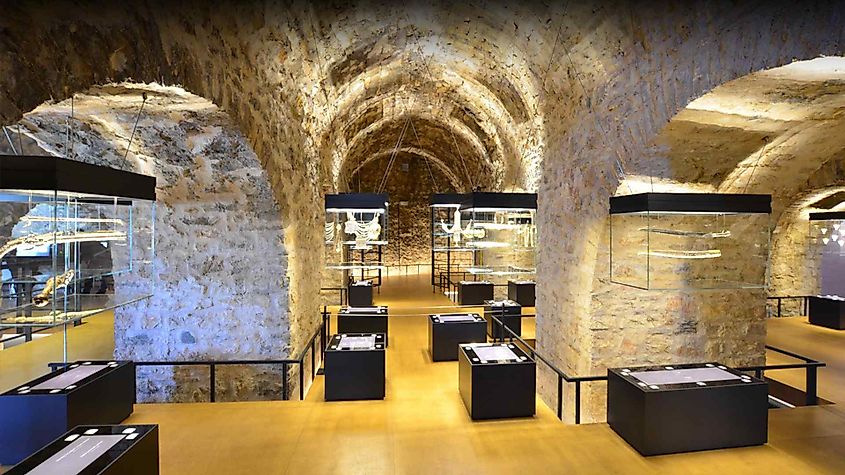
Interior of the Silversmithing Museum of Ioannina, via The Piraeus Bank Group Cultural Foundation.
The exhibition areas are on the bastion’s two levels. On the first level, the main part of the exhibition is displayed, and it includes the history and technology of silversmithing in Epirus. On the second level, the collection of silver- and gold-smithing works are presented, dating from the 18th through to the 20th century. Exquisite objects with ornamental details like pieces of jewellery, weapons and war objects, household silverware and other personal items are displayed.
The Museum, the city of Ioannina and if you have the time the surrounding mountains with their natural-designated paths are dream come true and a paradise for outdoor activities like river kayaking, mountain climbing and hiking.
The Museum Of The International Hippocratic Foundation Of Kos, Kos Island
In the southeast Aegean Sea lies a large complex of twelve large islands and several smaller ones, known as the Dodecanese Region, in which lies the island of Kos, a popular tourist destination along with its neighboring island of Rhodes.
Kos is known for its lovely sunny weather, and with only an average of 93 rainy days in a year, it is an excellent destination for over 9 months (you may want to avoid December, January and February) to enjoy its warm Mediterranean climate.
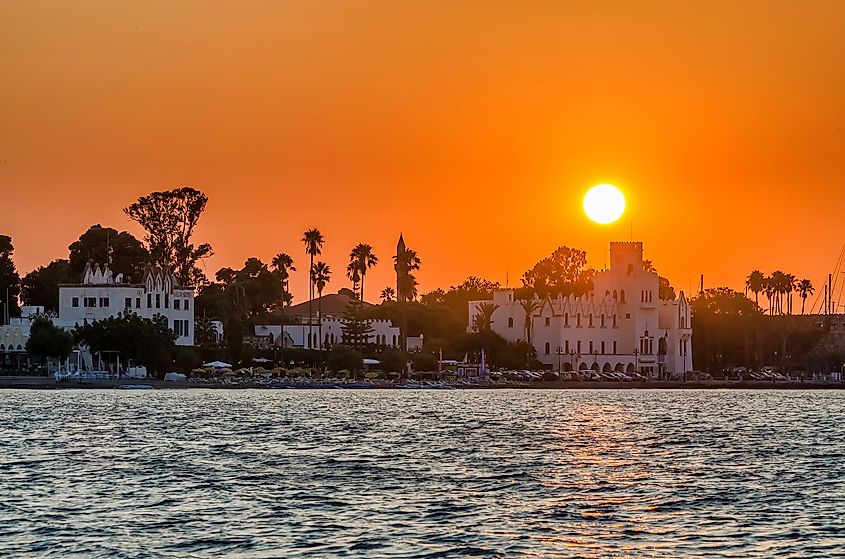
This ancient land rich in antiquities and landmarks to visit is also known as the birthplace of Hippocrates, the Father of Medicine. In antiquity, the island was a center of healing and many travelers seeking medical attention visited the sanctuary of Asclepios (Asklepion), a temple dedicated to the god Asclepios, the god of medicine and healing. It is the most important monument of the island and of the most important temples of its kind of antiquity. In the ancient times it was the place of worship of the god Asclepios, healing grounds for the ill and a school for the study of medicine. Hippocrates taught in the school that he established within the sanctuary's area.

The Rod of Asclepios, or the Staff of Asclepios, universally adopted sign of Medical Science, via the University of Florida, School of Medicine.
The Hippocratic Museum on the grounds of the International Hippocratic Foundation of Kos (IFHK) is located 0,5 km east from Asklipieion and 3,5 km south-west from Kos city centre. The building spreads over a hill with a unique view and its gardens host 140 of the 256 therapeutic plants that Hippocrates was cultivating for medicinal use.
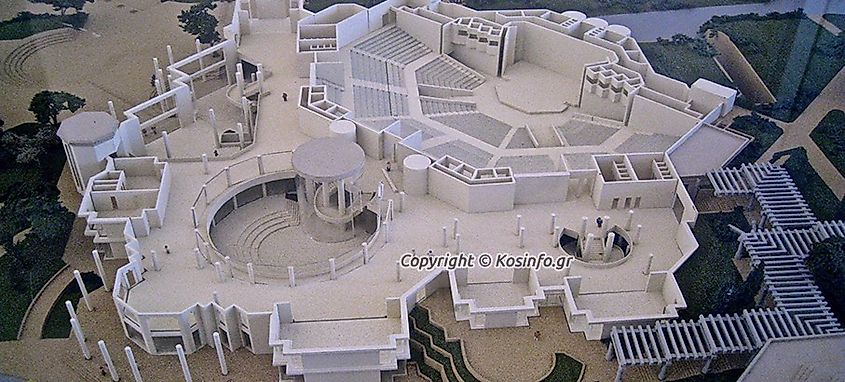
The building, housing the International Hippocratic Foundation of Kos, via Kosinfo.gr
The Museum is dedicated to the transmission of knowledge about Hippocrates and his influences on modern medical science.
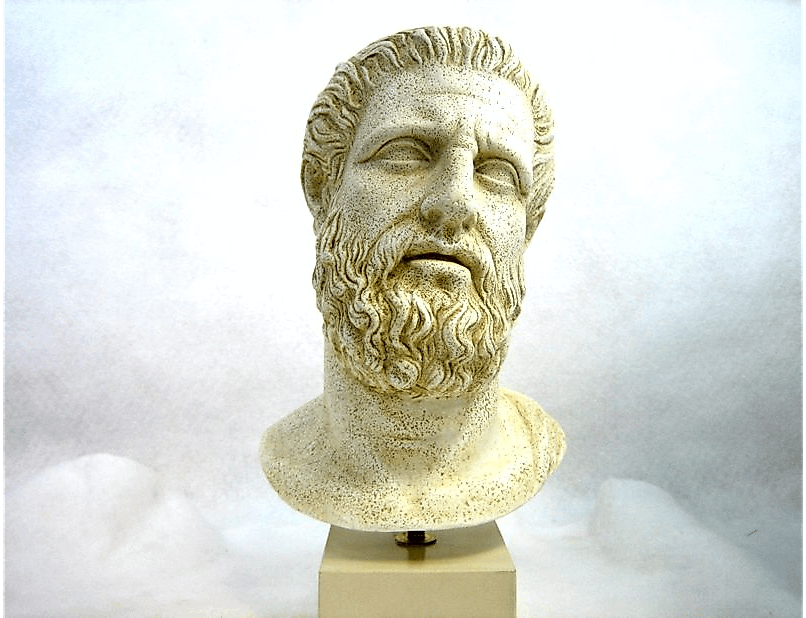
Marble bust of Hippocrates, via the International Hippocratic Foundation of Kos.
|
The text of the Hippocratic Oath (c. 400 BCE) is a translation from Greek by Francis Adams (1849). It is considered a classical version and differs from contemporary versions, which are reviewed and revised frequently to fit with changes in modern medical practice. (source Britannica.com) Video of an oath-taking ceremony recreated from its ancient ritual practices |
Visit Kos and the surrounding Dodecanese islands, preferably outside the peak season (June-August), and enjoy the sun the good weather, the warmth of the sea and an abundance of cultural and natural beauty hidden in these islands. Spend time on some of them, Rhodes, Kos, Karpathos, Kastelorizo, and take in their unique character and identity.
The museums in Greece are numerous, officially under the auspices of the Ministry of Culture there are 173 archaeological and Byzantine museums, some 60 or so folklore and historical museums, 25 art museums, 3 theatre museums, 2 cinema museums, 2 museums of musical instruments, 5 maritime museums, 4 museums of natural history, and 6 museums of science and industry. Yes, we lose count!
The ones I listed above are my personal favorites and they cover a variety of subject-matter, themes and locations worth visiting on their own accord—Athens, Thessaloniki, Ioannina, Delphi and Kos are in different regions of the country, each with its unique culture, history and natural beauty.
You may never be able to visit them all, but you can plan your next visit to Greece to accommodate a visit to any of these or maybe others that may take your fancy! Study and plan your visit well to take in as many of those hidden treasures as you can, and leave plenty of time to enjoy the cities and the beautiful nature you will come across wherever you chose to go.






